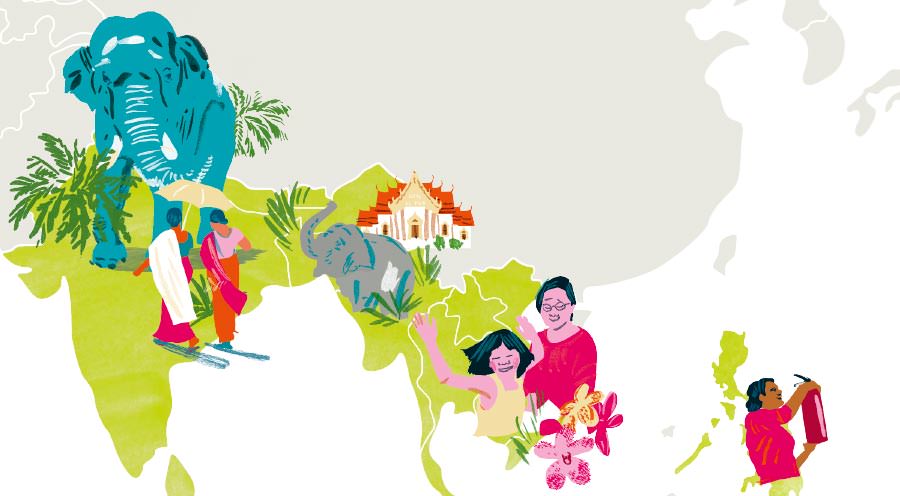Often you have to start small if you want to encourage a rethink about sustainable economics. About as small as a Cretan olive – planted and tended by farmers with the courage to strike out along new paths.

»I know exactly what my role in this life is. I can’t stay indoors. I belong outside among my olives.«
Dimitris Loumpakis is a Cretan farmer who manages his land sustainably. He recently joined a pilot project initiated by the TUI Care Foundation. The aim is to place wine and olive growing in Crete on a sustainable footing and to forge enduring links with tourism. We accompanied Dimitris and Sotiris Bampagiouris from Local Food Experts, who are implementing the island project for TUI, into the olive groves. In the Valley of Sarchos, 500 metres above sea level, we visited the Chonos Olive Grove, a chance to experience with all our senses what this cultural and economic asset means to the people who are committed to sustainable olive growing. Because for this mission you do need commitment: sustainable management is particularly labour-intensive. Out of respect for the soil and the surrounding vegetation, it dispenses with heavy machinery of the kind used in conventional agriculture.

Dimitris wouldn’t want it any other way. He keeps stopping in his tracks, handing us an organic lemon so we can appreciate the smell, gathering wild oregano and picking up walnuts from the edge of the path so we can crack them together. There is far more to this than the seductive scent of unfamiliar wild herbs and a scenery that strikes the visitor as idyllic: it is evidence of the equilibrium created by healthy local biodiversity. Here, the war against harmful pests is waged by drawing on the natural ability of diverse species to protect themselves. Those same mechanisms shield the parched earth, which struggles increasingly to cope with the long periods of drought that alternate with short, sharp downfalls of rain.


Tradition for the future
Nearly 95 per cent of the olives grown on Crete are processed into oil. Tasting that olive oil is an introduction to the many facets of this Greek island. The olive trees, with their typical gnarled trunks, are everywhere – a distinctive feature of this landscape.
Books will tell you that the oldest remains of cultivated olives were found on Crete. Given so much history and such close ties with this little drupaceous fruit which hangs so unassumingly from the branches, it is easy to understand why the farmers are proud. A lot of cultural heritage and identity comes with the olive groves and the products grown there. Almost 44 per cent of the agricultural surface area of Crete belongs to the olive trees. The island is one of the biggest exporters of olive oil in Europe.

The diversity found in the Chonos Olive Grove is representative of Crete as a whole. The largest of the Greek islands, with its 1,700 different species of flora, is one of Europe’s most biodiverse regions. And no less that 10 per cent of this versatile vegetation is endemic, which means that these plants do not grow anywhere other than in Crete.
The facts are impressive, but they come with a caveat: as things stand today, only a small proportion of the olive groves are farmed organically and sustainably. That is something this project backed by the TUI Care Foundation would like to change. Olive, wine and cereal growers can work together under the umbrella of this grass-roots initiative, which aims to put local producers like Dimitris in touch with partners in the processing sector and sustainable tourism. In the longer term, the objective is to develop Crete as a destination that sets a fine example for sustainable food production.

3 questions to
»Growing tourism endangers the Greek spirit. We make products to reinforce that spirit, so visitors can enjoy the authentic experience.«
Hidden riches
For Sotiris Bampagiouris from Local Food Experts, how agriculture responds to nature has an important preservation aspect. “Organic farming is not necessarily the same thing as sustainable agriculture. But that is what we are trying to encourage and achieve with our projects: sustainable management based on organic guidelines, using but at the same time protecting what is there,” Sotiris explains. He studied organic farming himself and has been campaigning for these principles on Crete for 22 years. “Everything from producing your own fertiliser to enlisting local species of flora and fauna to protect crops from insects and to preserve the soil.” That, says Sotiris, means respecting and remembering the traditional methods of olive cultivation.

»They say an olive tree never dies. They are intelligent trees and true artists when it comes to adapting.«
A day spent in the olive groves is a day full of Cretan history. An unlikely cluster of gnarled trees turns out to be living evidence of the past. These stately specimens are over 2,000 years old. They once witnessed Minoan culture, one of the most ancient civilisations in Europe. The rootstocks of these wild olive trees literally spring from a former era. Grafted onto them, in testimony to a more recent age, are cuttings from more productive strains. This is a propagation technique commonly used for roses and fruit.
Here on Crete, we might see it as a symbiosis between humans and nature. But that symbiotic relationship has not always been driven by knowledge and respect.
Sotiris and Dimitris tell us that in the 1990s, the government sent advisors who urged the farmers to replace their olive trees, many of them centuries old, with newer varieties that would yield a greater harvest. The philosophy at the time was to adopt intensive methods involving nitrogen fertilisers, milling machines and abundant irrigation. Many farmers now regret following that advice. The sustainable approach to olive cultivation taught by Local Food Experts at its agricultural seminars is designed to prevent such mistakes in the future. The association is treading new ground in Crete, and its work is intended to serve as a model: if the community wants to look ahead and to combine tourism with more sustainable economics, the foundations must be laid among the farmers. They will spread their insights, becoming the advocates of a conscious rapprochement that values traditional methods and cultivars. And they will create the places where visitors will have an opportunity to encounter authentic local cooking and culture.



Bonding over a good lunch
In the village of Kroussonas, we meet Manolis Kokologiannakis, a friend of Dimitris and Sotiris. He runs a restaurant here that has been in his family for several generations. But Manolis began his career as a chef in the hospitality sector. He was once in charge of producing well in excess of 100,000 meals a year at one of the big hotels on the Cretan coast. Now he manages the traditional family tavern.
The ingredients for the salad are from his own field, which is farmed in the traditional organic way. The pork is from a pig left to grow at its own pace, and the white wine was made from the vines that spring up all over the village. The full-bodied olive oil shimmering gold-yellow-green is the theme that holds the leisurely lunch together. Hot or cold, its effects are different with every dish, but each time it puts a perfect finishing touch to the taste experience. And so the traditional tasting ritual becomes an olive oil highlight. If only more visitors to Crete found their way to local restaurants like the one Manolis runs. Not just for their own sheer enjoyment, but also so that talented people with good ideas are given a chance to put those ideas into practice. That will create new prospects in a rural region that is suffering from an exodus of young people.
Local initiatives like this one draw strength from Crete’s development as a model destination for sustainable holiday eating, which is being driven forward by the TUI Care Foundation in conjunction with Futouris and the social enterprise Local Food Experts. If people living in the destinations are to benefit in the long term from the feedback effects of projects like this one, the links between the local economy and tourism must start with the little things.















